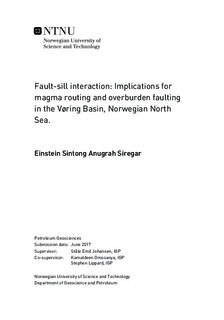Fault-sill interaction: Implications for magma routing and overburden faulting in the Vøring Basin, Norwegian North Sea.
Master thesis
Permanent lenke
http://hdl.handle.net/11250/2454587Utgivelsesdato
2017Metadata
Vis full innførselSamlinger
Sammendrag
Magmatic sills in the study area are positive high amplitude anomalies with similar polarity as the seabed reflection. The sills have saucer, transgressive and concave-up geometries occurring at three principal stratigraphic intervals but importantly formed an interconnected sill complex at depth of about -5000 ms TWTT. Sill-sill interactions are identified based on sill-sill junction types. Area coverage of magmatic sills in this study area include 15.2 to 94.3 km2 for shallow sills, 8.8 to 186.4 km2 for intermediate sills and 48.4 to 186.4 km2 for the deeper sills. An evidence for lateral migration of sills for longer distances upon ascent from a magma chamber.
To understand the importance of fault-sill interaction, 136 faults associated with magmatic sills were interpreted and studied for their throw-depth (T-z) and displacement (D-x) characters. Magmatic sills in the Naglfar Dome show disparate relationship with faults. At fault-sill junctions, C-type junctions are predominant. The propagation of magma through pre-existing faults causes formation of inclined sheets, intrusive steps, and reorientation of magma flow along faults strike. Thirteen (13) magmatic sills associated with hydrothermal vents in the study area have eye-, dome-, crater-, and pyramid-shaped upper parts. Vertical ascent of hydrothermal fluids caused local perturbation of the stress state within the overlying polygonal faults creating radial faults at the tops of the vents.
This thesis describes the complexity of fault-sills interaction in magma-rich basins and represents a good case study to understand the role of faults during subsurface magma plumbing. This thesis has broader implications for regional tectonic history, mineral exploration and hydrocarbon prospectivity.
